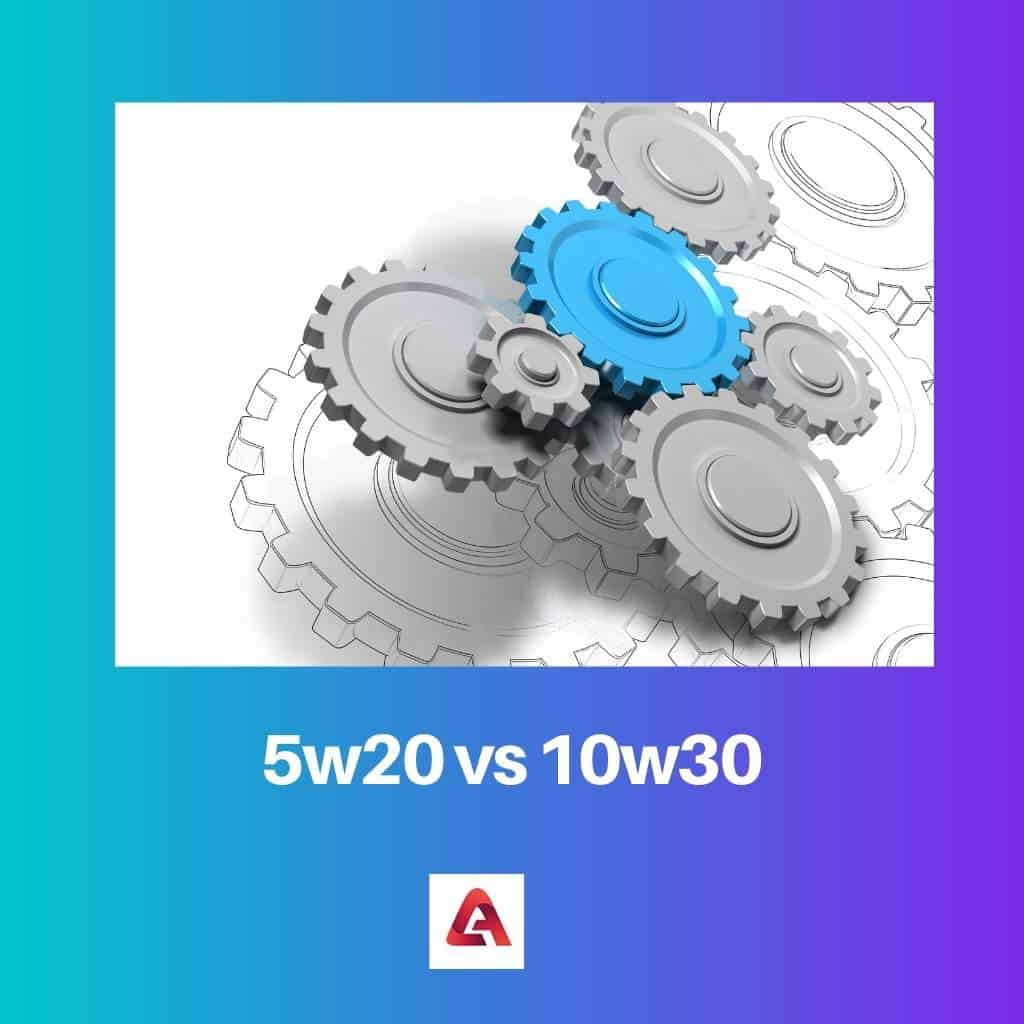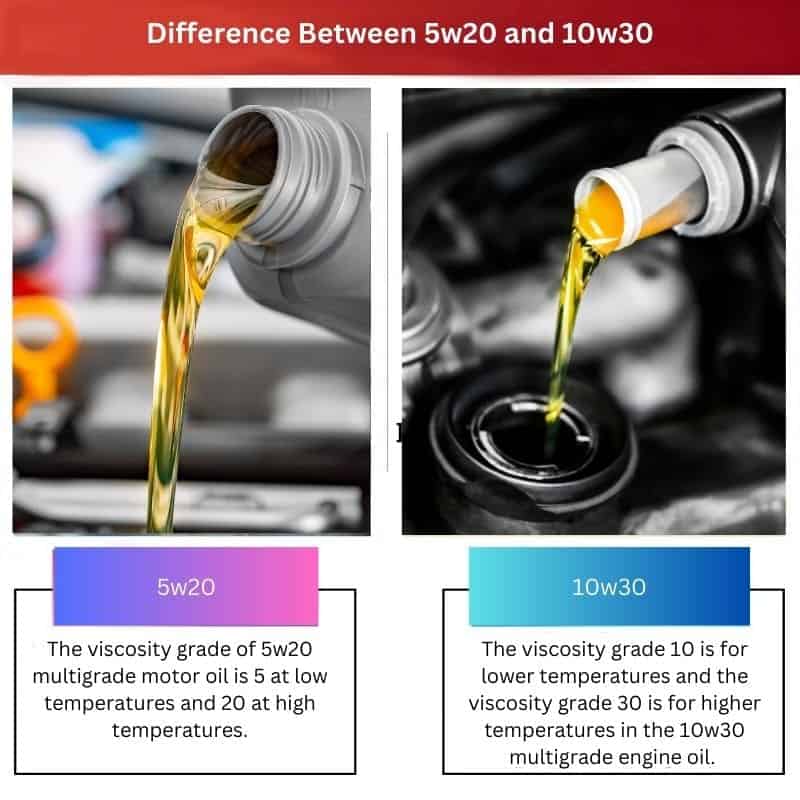Engine oil is a lubricant used in automobile engines, especially internal combustion engines. Engine oil, commonly referred to as engine oil or engine lubricating oil, is a liquid used to lubricate the engine.
Multigrade oils have two viscosity grades: one for viscosity at low temperatures (denoted with a “W” for winter) and another for viscosity at higher temperatures (denoted with “H” for summer). Multi-grade oils are 10w30 and 5w20.
Key Takeaways
- 5W20 and 10W30 refer to different grades of engine oil.
- 5W20 has better fuel efficiency and is recommended for newer engines, while 10W30 provides better protection at higher temperatures and is recommended for older engines.
- 5W20 has a lower viscosity than 10W30, meaning it is thinner and flows more easily at lower temperatures.
5w20 vs 10w30
The low w of 5W20 indicates that 5W oils will flow more quickly in cold conditions since they will remain thinner and easily circulate throughout the engine for greater start-up protection. In contrast, it is advised to use 10W30 in older engines because it offers better protection at higher temperatures.

5w20 is multi-viscosity engine oil that’s used in cars. It’s one of the Society of Automotive Engineers (SAE) Standard viscosity grades, used to keep the engine running at various temperatures.
The cold-temperature viscosity value is 5, while the high-temperature viscosity rating is 20. They’re thin enough to flow efficiently at low temperatures, so in cold conditions, the oil will thicken less and offer sufficient engine lubrication
10w30 is also a multi-grade engine oil primarily used in vehicles with heavy-load engines due to its ability to withstand high temperatures for an extended period without compromising engine performance.
Because older engines need heavier oil for optimal engine lubrication and engine lifespan, 10w30 is one of the most recommended oil grades for commercial vehicles with older engines.
Comparison Table
| Parameters of Comparison | 5w20 | 10w30 |
|---|---|---|
| Viscosity | Lower. | High. |
| Works | Within the temperature range -30 degrees to 35 degrees celsius. | Within the temperature range -18 degrees to 30 degrees celsius. |
| At Low Temperature | Thinner. | Thicker. |
| Provides | Cold weather starting. | Sealing Action. |
| Used By | Light duty petrol and diesel engines. | Heavy load-hauling engines. |
What is 5w20?
The viscosity grade of 5w20 multigrade motor oil is 5 at low temperatures and 20 at high temperatures. At low temperatures, it has a low viscosity grade, which implies the oil is thin.
Correspondingly, the oil thickens as the temperature rises. 5w20 engine oil meets API SN standards and, depending on the brand, has an ACEA grade. MB approval is also included in 5w20.
Mercedes-Benz approval refers to Mercedes-Benz standards that give an engine oil grade. The MB rating of 5w20 is also determined by the oil brand. In addition, VW approval (Volkswagen oil standards), Ford oil specifications, and Porsche oil specifications are also included in 5w20.
5w20 offers a lot of advantages and characteristics that aren’t seen in other oils. It creates a continuous coating of overall engine components, which reduces friction between moving parts.
They minimize engine wear and tear while keeping the engine cool during start/stop operations. They help keep the engine components from rusting. Engine oil, in general, extends the life of the engine.
They have excellent thermal stability, which means they retain their characteristics even when temperatures fluctuate dramatically. It is also intended to reduce oil consumption since a small quantity of engine oil is required to lubricate an engine.

What is 10w30?
The viscosity grade 10 is for lower temperatures, and the viscosity grade 30 is for higher temperatures in the 10w30 multigrade engine oil. At low temperatures, 10w30 oils have a viscosity of 10, while at high temperatures, they have a viscosity of 30.
At lower temperatures, it has a low viscosity grade, indicating that the oil is thin. At higher temperatures, the oil also thickens. API SN, ACEA grade, and viscosity grade are some of the qualities required for 10w30 oil.
The American Petroleum Institute created the API SN engine oil category to show oil that meets certain requirements. The engine must be capable of protecting the piston from deposits created by fuel combustion.
It must have superior sludge management, meaning it should not produce any unwanted gels or sludge at higher temperatures. Seal compatibility and post-processing compatibility are also required.
They keep the engine cool while reducing engine wear and tear during start/stop operation. They also help to prevent rusting of engine components. 10w30 engine oil, on the whole, extend the life of engines.
It is possible to have a smooth clutch and gear action. Consequently, it is possible to run the engine without making any noise. Even when the temperature varies much, it maintains its viscosity.

Main Differences Between 5w20 and 10w30
- The viscosity of 5w20 is lower compared to 10w30, whereas the viscosity of 10w30 is higher compared to 5w20.
- 5w20 works within the temperature range of -30 degrees to 35 degrees Celsius, whereas 10w30 works within the temperature range of -18 degrees to 30 degrees Celsius.
- 5w20 is thinner at lower temperatures, whereas 10w30 is thicker at lower temperatures.
- 5w20 is better for cold-weather starting, whereas 10w30 is better for sealing action.
- Light-duty petrol and diesel engines use 5w20, whereas large-weight carrying engines need 10w30.


Multigrade oils play a pivotal role in the engine’s performance and durability. It’s crucial to understand the specific requirements of one’s engine in order to select the most appropriate viscosity grade. This article provides a comprehensive comparison between 5W20 and 10W30, shedding light on their individual characteristics and best use cases.
Absolutely, the article effectively highlights the importance of viscosity in engine oil and how it directly affects the engine’s performance under different conditions. It’s essential information for every vehicle owner.
I completely agree. The detailed explanation of the viscosity grades and the comparison table provide valuable insights for anyone looking to make an informed decision about the engine oil for their vehicle.
The detailed comparison table effectively outlines the differences in viscosity and temperature suitability of 5W20 and 10W30 oils. It’s an invaluable resource for vehicle owners seeking to make the best choice for their engine’s lubrication needs.
The detailed exploration of the benefits and characteristics of 5W20 and 10W30 oils presents a comprehensive understanding of their roles in engine lubrication. It’s a valuable resource for anyone seeking to enhance their knowledge of engine maintenance.
Certainly, the article’s focus on the specific temperature ranges, viscosity differences, and fuel efficiency implications of 5W20 and 10W30 oils offers a comprehensive perspective on engine oil selection. It’s a commendable piece.
Absolutely, the detailed examination of 5W20 and 10W30 oils provides valuable insights for vehicle owners, empowering them to make informed decisions about engine lubrication and care.
The thorough comparison of 5W20 and 10W30 oils offers valuable insights into the specific scenarios where each grade is most effective. It’s an enlightening read for anyone interested in optimizing engine lubrication.
Absolutely, the article effectively communicates the crucial differences between 5W20 and 10W30, equipping readers with essential knowledge to make informed decisions about selecting the most suitable oil for their engine.
Indeed, the article’s in-depth analysis of 5W20 and 10W30 provides a holistic view of their respective uses, temperature suitability, and impact on engine performance. It’s an excellent resource for vehicle maintenance.
The significant advantages and specific use cases of 5W20 and 10W30 oils are brilliantly articulated in this article. It’s a comprehensive guide to understanding how different viscosity grades impact engine performance and durability.
Definitely, the detailed explanation of the pros and cons of 5W20 and 10W30 provides valuable insights for vehicle owners, allowing them to make well-informed decisions about the ideal oil for their engines.
The comprehensive overview of 5W20 and 10W30 presented in this article is highly informative. It’s particularly helpful in understanding the differences in viscosity and the specific scenarios where each grade is most suitable for optimal engine performance.
I found the comparison table to be particularly useful in highlighting the differences between 5W20 and 10W30. It’s a clear and concise reference for understanding which grade aligns with specific engine requirements.
Indeed, the article does a commendable job of explaining the characteristics and benefits of each viscosity grade. It’s a valuable resource for vehicle owners who want to make well-informed decisions about engine oil selection.
The comparison between 5W20 and 10W30 presented here provides a comprehensive understanding of the unique characteristics of each viscosity grade. It’s an informative read for anyone looking to optimize their engine’s performance and longevity.
Absolutely, the article’s emphasis on the specific temperature conditions, fuel efficiency, and engine protection offered by 5W20 and 10W30 oils is enlightening. It’s crucial information for engine maintenance and care.
The article provides a comprehensive breakdown of the advantages and characteristics of 5W20 and 10W30, contributing to a deeper understanding of their respective functions and compatibility with different engine requirements.
Absolutely, the detailed examination of 5W20 and 10W30 oils’ traits and applications facilitates informed decision-making for vehicle owners, enabling them to prioritize engine health and performance.
The detailed description of 5W20 and 10W30, along with their respective benefits, is a valuable resource for anyone seeking to understand the significance of engine oil viscosity grades. This article provides compelling insights into the selection of the most suitable oil for different engine types and conditions.
Absolutely, the article offers an in-depth analysis of the distinctive properties of 5W20 and 10W30 oils, enabling readers to make informed decisions based on their specific engine requirements. It’s an excellent guide for vehicle owners.
The article delivers a thorough analysis of the unique benefits and specific applications of 5W20 and 10W30 oils. It’s an excellent resource for enhancing one’s understanding of engine oil viscosity and its influence on engine performance.
Absolutely, the article provides a comprehensive exploration of the distinct properties of 5W20 and 10W30, serving as a valuable reference for individuals looking to make informed choices regarding engine oil selection.
I agree, the emphasis on fuel efficiency, engine protection, and temperature range applicability offers a detailed perspective on the importance of selecting the right viscosity grade for different engine types. It’s a commendable article.